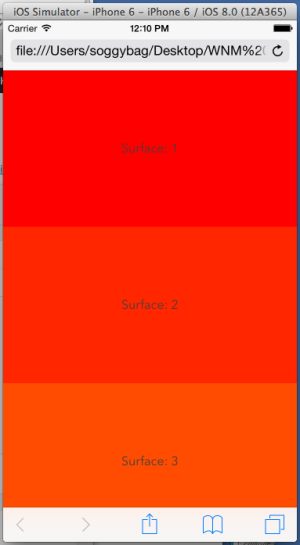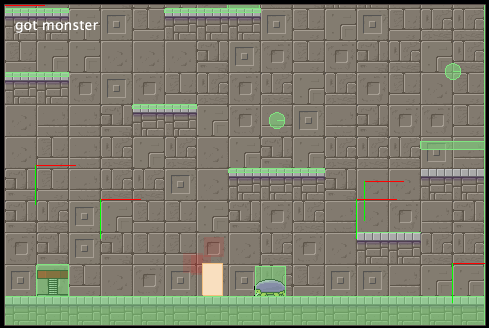I just found out you can now use the camera and the microphone with JS. This all hinges on: navigator.getUserMedia. At this time it only has partial support and you’ll need to use a browser prefix for all of the popular browsers. You can check support here.
Note! You can’t use navigator.getUserMedia from a URL that begins with file://. This means you can’t use this command when testing your project from the desktop! You will need to create a local server on your computer, or upload your files to your web host and test them from there.
If you’re looking for a local web host try MAMP (Mac), or WAMP (Windos). These are simple and easy to use.
Since navigator.getUserMedia() is not implemented by all browsers (yet), you’ll need to check for the vendor specific function: webkitGetUserMedia, mozGetUserMedia, msGetUserMedia. THe block below assigns the vendor method to navigator.getUserMedia, after which you’ll use that name.
if (!navigator.getUserMedia) {
navigator.getUserMedia = navigator.getUserMedia || navigator.webkitGetUserMedia ||
navigator.mozGetUserMedia || navigator.msGetUserMedia;
}
Next choose a media source, and set success, and error callbacks.Notice the first parameter for getUseMedia is an object with properties: audio, and video. Set the media type you wish to access to true.
if (navigator.getUserMedia) {
navigator.getUserMedia({
audio: true,
video: true
}, success, error);
} else {
alert('getUserMedia not supported in this browser.');
}
What happens with the callbacks is up to you. For the error, you might as well log a message.
function error() {
console.log("Couldn't get a stream.");
}
On a success, what to do is a little more involved. The success method will receive a stream. The data in the stream will depend on the device.
function success(stream) {
// Here you have connected to a device, and are receiving a stream.
}
The success handler returns a MediaStream object which represents a stream of audio and video data. How you handle this depends on what you want to do and what time of stream, you requested: audio, video, or both.
The MediaStream Object can be assigned to a DOM element. Which makes for an easy way to display a video stream. Audio on the other hand doesn’t really sense if you attach it to a an audio tag. Most often you probably will not want to play audio as you are recording it.
Image Capture example…
HTML
<div class="camera">
<video id="video-still">Video stream not available.</video>
<button id="startbutton">Take photo</button>
</div>
<canvas id="canvas">
</canvas>
<div class="output">
<img id="photo" alt="The screen capture will appear in this box.">
</div>
JavaScript
// ** Capture a still image **
// This block of code is contained in a self invoked function.
(function() {
// Set a width and height for the video/image
var width = 320; // We will scale the photo width to this
var height = 0; // This will be computed based on the input stream
// |streaming| indicates whether or not we're currently streaming
// video from the camera. Obviously, we start at false.
var streaming = false;
// The various HTML elements we need to configure or control. These
// will be set by the startup() function.
var video = null;
var canvas = null;
var photo = null;
var startbutton = null;
// ****************************************************************
// Start capturing video
function startup() {
// Define elements
video = document.getElementById('video-still');
canvas = document.getElementById('canvas');
photo = document.getElementById('photo');
startbutton = document.getElementById('startbutton');
// Check for vendor version of getUserMedia
navigator.getMedia = (navigator.getUserMedia ||
navigator.webkitGetUserMedia ||
navigator.mozGetUserMedia ||
navigator.msGetUserMedia);
// Check for getUserMedia
if (!navigator.getMedia) {
// No user media exit
console.log("Has get user media");
return;
}
// invoke getUserMedia to start a video stream.
navigator.getMedia({
video: true, // Get video
audio: false // No audio
}, getMediaSuccess, getMediaError); // Pass a success, and error function
// Media success function
function getMediaSuccess(stream) {
// Check for FireFox.
if (navigator.mozGetUserMedia) {
video.mozSrcObject = stream; // Assign the stream to #video-still
} else {
var vendorURL = window.URL || window.webkitURL;
video.src = vendorURL.createObjectURL(stream); // Assign the stream to #video-still
}
video.play(); // Tell #video-still to play
}
// This is invoked on a user media error.
function getMediaError(error) {
console.log("An error occured! " + error);
}
// Add an event to the #video-still. The canplay event occurs when
// the video is ready to play.
video.addEventListener('canplay', function (event) {
// Check the streaming flag.
if (!streaming) {
// Not streaming.
// Get the height of the video
height = video.videoHeight / (video.videoWidth / width);
// Firefox currently has a bug where the height can't be read from
// the video, so we will make assumptions if this happens.
if (isNaN(height)) {
height = width / (4 / 3);
}
// Set some attributes of the #video-still element
video.setAttribute('width', width);
video.setAttribute('height', height);
canvas.setAttribute('width', width);
canvas.setAttribute('height', height);
// Set streaming to true
streaming = true;
}
}, false);
// Add click event to #startbutton
startbutton.addEventListener('click', function (event) {
event.preventDefault();
takepicture(); // Take a picture
}, false);
clearphoto();
}
// End startup function
// ****************************************************************
// #canvas is used to hold a still image. Here the convas is cleared
// by filling with gray.
function clearphoto() {
// Fill with a gray
var context = canvas.getContext('2d');
context.fillStyle = "#AAA";
context.fillRect(0, 0, canvas.width, canvas.height);
// Set the data url of #photo to the image on the canvas
var data = canvas.toDataURL('image/png');
photo.setAttribute('src', data);
}
// Capture a photo by fetching the current contents of the video
// and drawing it into a canvas, then converting that to a PNG
// format data URL. By drawing it on an offscreen canvas and then
// drawing that to the screen, we can change its size and/or apply
// other changes before drawing it.
// Capture an image.
function takepicture() {
var context = canvas.getContext('2d');
if (width && height) {
canvas.width = width;
canvas.height = height;
context.drawImage(video, 0, 0, width, height);
var data = canvas.toDataURL('image/png');
photo.setAttribute('src', data);
} else {
clearphoto();
}
}
// Set up our event listener to run the startup process
// once loading is complete.
// This calls startup (above)
window.addEventListener('load', startup, false);
})();

